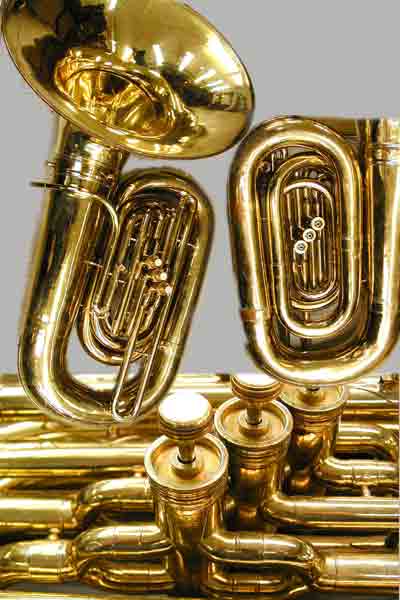Page 1 of 1
Buescher split-bore concept
Posted: Wed Jul 22, 2009 6:28 am
by MileMarkerZero
Has anyone ever seen, much less played a horn like this?

The thought process was that by splitting the bore into two smaller tubes, the valve stroke can be halved.
Here is Buescher's sketch:

Looks like an interesting concept, but I'm not sure how practical it was or could be.
Re: Buescher split-bore concept
Posted: Wed Jul 22, 2009 7:36 am
by imperialbari
Sounds interesting. Wonder whether it also sounds interesting.
Klaus
Re: Buescher split-bore concept
Posted: Wed Jul 22, 2009 5:08 pm
by Tuba Guy
Is it like french horn style double?
Re: Buescher split-bore concept
Posted: Wed Jul 22, 2009 6:02 pm
by imperialbari
If this concept shall have any chance, then the two split oscillating air columns shall be in exact sync/phase/whatever, when they are rejoined. I doubt that being possible for all notes over a full range.
Re: Buescher split-bore concept
Posted: Wed Jul 22, 2009 6:57 pm
by windshieldbug
Tuba Guy wrote:Is it like french horn style double?
No.
All tubes are open ALL the time... the air column is split, then rejoins itself. The total volume is bigger, but the split airways are smaller, meaning the valve only has to travel half as far.
Re: Buescher split-bore concept
Posted: Wed Jul 22, 2009 7:09 pm
by Tuba Guy
Ohhh...cool. I'd love to try one of those
Re: Buescher split-bore concept
Posted: Wed Jul 22, 2009 8:15 pm
by Matt G
Probably not all that great because there is a huge difference between splitting the airstream (volume) and slitting the frequency/buzz/pitch/waveform/etc. If this were a design for a water or airflow valve system, it would probably be fine. Since it is in conjunction with a resonating column of air, it sucks.
Re: Buescher split-bore concept
Posted: Wed Jul 22, 2009 9:36 pm
by sailn2ba
I would think that the narrower passages would change the harmonics. The sound is a result of energy conversion, not just mass flow.
Re: Buescher split-bore concept
Posted: Thu Jul 23, 2009 12:31 am
by Mikelynch
The elephant is profoundly correct.
This configuration of tuba was sold under the name of Harry (S?) Pedler, and I own one of these tubas (don't ask--I'm a softy for a really odd horn . . .). I understand Mr. Pedler to have been an employee of Reynolds at one point.
While not wanting to diminish enthusiasm for innovation, not all new ideas are good ideas. And there is a reason that one is much more able to locate a Conn short action horn than its Pedler counterpart.
It is an interesting concept, but in terms of overall success in manufacturing horns with short action valves, the continuum seems to be (in descending order): Conn--King (rotors)--Allen(Rotors)--Holton--XXX?--Pedler . . .
Mike Lynch
Re: Buescher split-bore concept
Posted: Thu Jul 23, 2009 1:20 am
by MileMarkerZero
I think my favorite way of shortening the valve stroke on a rotary horn is the way Alexander does it on the model 173:

If you look closely, you'll see that the valves ALL face rearward.
I can't really give a technical description of all the parts, but essentially there is a mechanical advantage to the way that the connecting rod goes to the back of the horn that shortens the valve stroke. I played one of these at a TubaChristmas a number of years ago, and the spatula throw was somewhere between a french horn and a Conn short action. VERY fast. I'm surprised that no other makers have tried this, except that it makes the "business" side of the rotary valve harder to get to.
Re: Buescher split-bore concept
Posted: Thu Jul 23, 2009 7:56 am
by imperialbari
windshieldbug wrote:The total volume is bigger, but the split airways are smaller, meaning the valve only has to travel half as far.
If the valve stroke is halved, the combined square area of the two smaller tubes will be half the one of the pre- and post- tubing.
Klaus
Re: Buescher split-bore concept
Posted: Thu Jul 23, 2009 9:46 am
by Dan Schultz
imperialbari wrote:windshieldbug wrote:The total volume is bigger, but the split airways are smaller, meaning the valve only has to travel half as far.
If the valve stroke is halved, the combined square area of the two smaller tubes will be half the one of the pre- and post- tubing.
Klaus
Actually.... the stroke is not cut in half... unless you decrease the seal area around the ports by half, too.
In my opinion, the 'split-bore' concept could not work without very precise attention to the assembly and alignment of the valve section.
Holton also made a few 'short-action' sousaphones. Mine plays OK but is no match for the Conn 'short-action' setup. Here's what the Holton set-up looks like:





